
|

|
|
Home Site Search Contact Us Subscribe
|
|
Martin Puryear ... artist, sculptor, and possibly architect? The United States Pavilion at the Venice Biennale Arte 2019: "Martin Puryear: Liberty/Libertà" By Johannes M.P. Knoops, Assoc. AIA, FAAR May 30, 2019 As a writer, I always take great delight when given the opportunity to preview a Venice Biennale, whether it’s the Biennale of Art or of Architecture, they are always times to reflect on the milieu we live in. The opening of this 2019 International Art Exhibition was particularly poignant.
Ralph Rugoff of London’s Hayward Gallery serves as the curator of the 2019 Venice Biennale Arte (through November 24). He titled this year’s Biennale, “May You Live in Interesting Times,” a phrase he refers to as a “counterfeit curse.” It’s Rugoff’s commentary on just how precarious our times really are. He claims the phrase should not be thought of as a theme, but rather as “a kind of guide for how to live and think in interesting times.”
In response to this, Martin Puryear was keenly selected to represent the United States at its National Pavilion in the Giardini, the Biennale Gardens. Organized by Brooke Kamin Rapaport of the Madison Square Conservancy, the U.S. Pavilion appeared on every journalist’s shortlist. When describing the artist’s challenge, Holland Cotter, art critic with the New York Times, wrote that it “can’t be easy in an American moment tense with divisive politics, resurgent racism, and gun violence.” Ironically, the U.S. Ambassador to Italy, Lewis Eisenberg, took it all differently, or rather indifferently, as he praised the “great times that we live in today” at the Pavilion’s opening on a wet morning of pre-opening events. He went on to extol the freedoms and liberties that define our time. Perhaps more precisely, it’s these bipolar realities that need exploring, where opposing truths coexist, each indifferent to the other, where common ground is scarce and passions are peaked.
A nuanced discourse – Puryear’s art that whispers to us
Thankfully, “Martin Puryear: Liberty/Libertà” transports us to a more nuanced discourse, where meaning is latent and comprehension only comes with reflection. At age 77, Puryear has long been an artist who exudes gravitas. He is not a frivolous man. Unlike much of today’s art, his work does not resort to shock value in order to convey meaning. Yet, Puryear’s art is not to be taken lightly.
His sculptures often anchor and define a space, whether it’s a room or a field. Onlookers orbit the works as they fall into their gravitational pull. This is no less true than in this Biennale installation designed by New York architects Tod Williams and Billie Tsien. Known for their designs of several landmark museums, such as the Barnes Foundation in Philadelphia and the tragically lost American Folk Art Museum in New York City, the architects used their expertise to speak softly. Creating an almost sacred ambiance, it’s Puryear’s art that whispers to us in the spiritual glow of ambient light that fills the pavilion.
Designed in 1929-30 by another team of celebrated New York architects, William Adams Delano and Chester Holmes Aldrich, the U.S. Pavilion invokes the classical idiom of Jefferson’s Monticello. But this year, the exterior of the pavilion has been redefined with what has been described as a veil – an architectural lattice that now clearly defines a forecourt through which one must pass. Like a walled-forecourt to an Early Christian church or Bernini’s colonnade that defines Saint Peter’s Square, it serves as the boundary to a sacred precinct where the profane is kept at bay and the sacred is safeguarded within.
Created in collaboration with Williams and Tsien, Puryear’s piece “Swallowed Sun (Monstrance and Volute), 2019” is perfectly scaled to the context by corresponding to the existing dimensions of the building. Constructed of southern yellow pine, steel, polyester, canvas, and rope, it embodies multiple references: the volute of an Ionic column capital, the grid of a coffered dome in perspective, an ecclesiastical monstrance for the veneration of the body of Christ, a black hole, and maybe even an intestinal tract.
Though a product of a Catholic upbringing and education, Puryear’s vocabulary is an open dogma that invites personal interpretations. He lovingly crafts his sculptures with a variety of woods and materials. He takes full responsibility for their materiality, a trait one can attribute to his two years in the Peace Corps where studied various indigenous West African crafts from the people he taught. This was a period after his graduation from Catholic University in Washington, DC (BA, 1963), and prior to his graduate studies in Sweden and at Yale’s School of Art and Architecture (MFA, 1971).
At the opening, Puryear was given an opportunity to address the assembled press and VIPs. Rather than delving into his motivations behind the work, all he communicated was his genuine gratitude for the opportunity. His warm tone conveyed sincerity, and his brevity implied that each of us must find meaning in the work on our own. He is clearly a meditative man and not a preacher – though he provides us with clues in the title of each sculpture.
An architecture of hushed narratives
Amusingly it wasn’t until the 11th hour, after all the catalog entries were written, that he provided the title for the central interior sculpture that now occupies the space below the Jeffersonian dome. It threw the catalog authors into a tizzy to learn he was titling it “A Column for Sally Hemings 2019.” It was a cause for most to re-write their entries to address this unforeseen narrative. (Not surprisingly, the catalogs were not available for the preview week, and are expected to arrive sometime in June.) If seen without a title, “A Column for Sally Hemings 2019” is a mystical sculpture, but with its title its true meaning is revealed. It becomes profound and invokes reflection. In his highly individualistic language, he crafted a Doric column – not a ubiquitous one, but one that eloquently tapers as it rises, whose fluted surface reminds us of pleats in a dress. In lieu of a column capital, Puryear pierces its body with a pin and shackle. The whole of which addresses the visitor eye-to-eye – the shackle in your face.
This and “Monstrance” are the two site-specific works made specifically for this Biennale, though all the other equally thought-provoking sculptures were in process when he got the call.
His works take on issues of scale. They often house objects within. Puryear has defined an architecture of hushed narratives for himself. But rather than surveying each of the works here, I implore you to take the journey and discover their meanings on your own terms in Venice.
May You Live In Interesting Times through November 24, 2019
Johannes M. P. Knoops, FAAR, Assoc. AIA, is a designer, educator and keen observer of objects, places and memories. You can find him most often with his students at the Fashion Institute of Technology/SUNY in his native New York City. www.knoops.us
Also by Knoops:
"Freespace"... The One Word of the 2018 Venice Biennale, the 16th Exhibition of Architecture A survey of just 10 of the 65 national pavilions chosen for their translation of "Freespace" - and in no particular order other than my own itinerary.
Kenneth Frampton, a New York Lion ... now a Golden Lion of the Venice Architecture Biennale As the Ware Professor at the Columbia University Graduate School of Architecture, Planning and Preservation, where he has taught since 1972, he has shaped more than one generation of architects. (2018)
More
Heart and Soul than Ever Before: 15th Venice Architecture Biennale
"Reporting from the Front"
The
Great Compilation: 14th International Exhibition of Architecture di la Biennale
di Venezia
|
(click on pictures to enlarge) 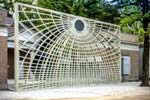 Joshua White – JWPictures.com Swallowed Sun (Monstrance and Volute), 2019. Southern yellow pine, steel, polyester, canvas, rope; Two parts, overall 22 ft. 8 in. × 44 ft. × 24 ft. 3 in. 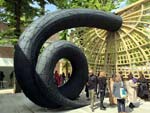 Johannes Knoops ©2019 Swallowed Sun (Monstrance and Volute), 2019, reverse view 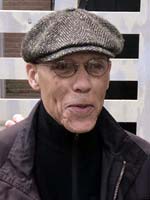 Johannes Knoops ©2019 Martin Puryear speaking at the opening of the U.S. Pavilion. 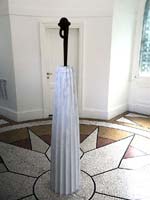 Johannes Knoops ©2019 A Column for Sally Hemings 2019. Cast iron, painted tulip poplar; 80 x 15 3/4 x 15 3/4 in. 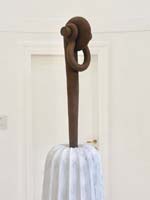 Johannes Knoops ©2019 A Column for Sally Hemings 2019, detail 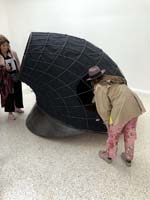 Johannes Knoops ©2019 Tabernacle, 2019. Steel, red cedar, American cypress, pine, makore veneer, canvas, printed cotton fabric, glass, stainless steel; 74 x 90 x 96 in. 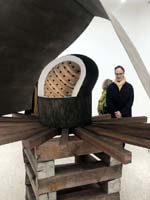 Johannes Knoops ©2019 Cloister-Redoubt or Cloistered Doubt?, 2019, with Martin Puryear's gallerist Matthew Marks. American hemlock, Eastern white pine, tulip poplar, red cedar, 99 1/2 x 96 x 53 in. 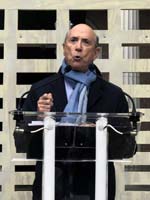 Johannes Knoops ©2019 Lewis Michael Eisenberg, United States Ambassador to Italy. |
© 2019 ArchNewsNow.com